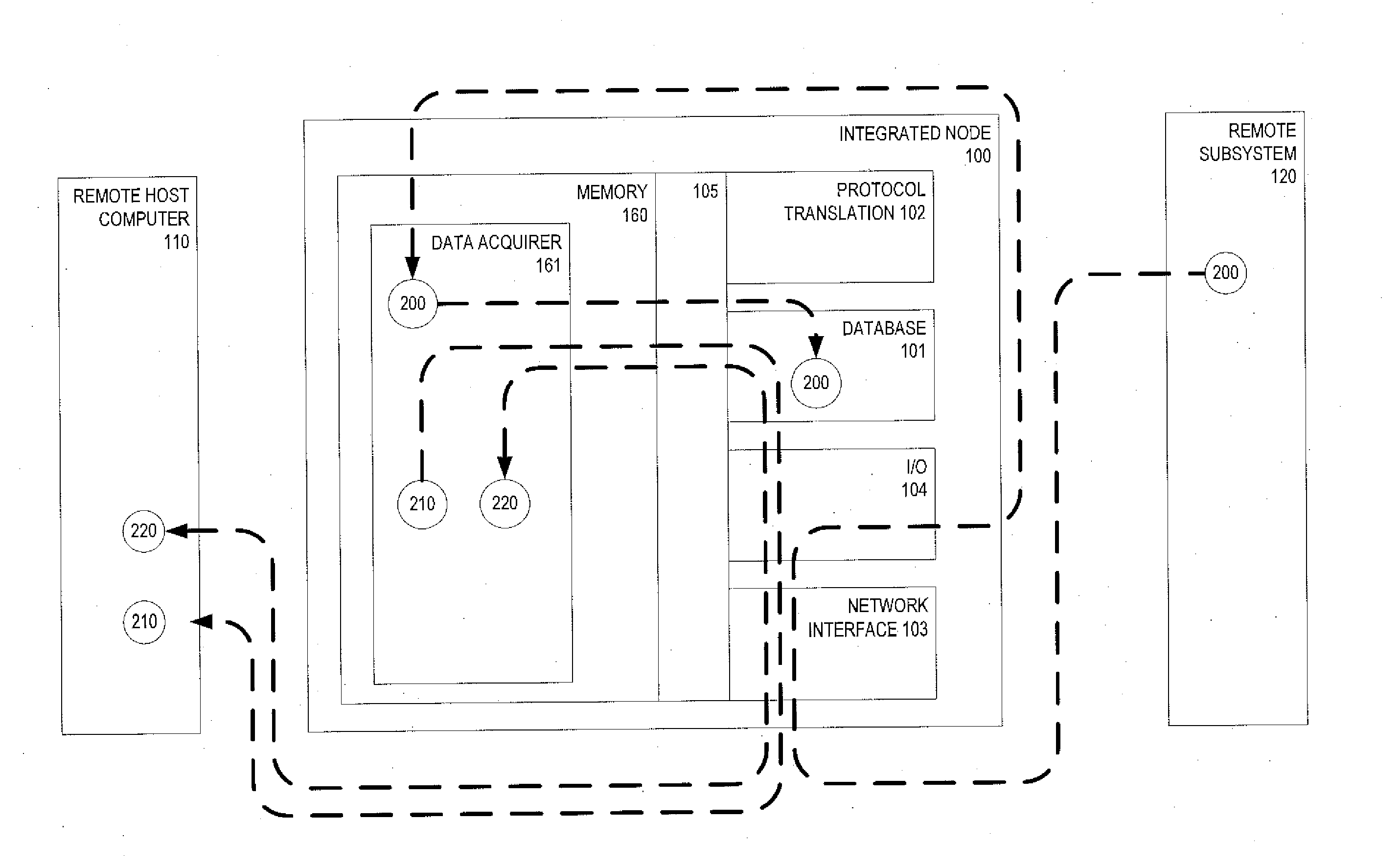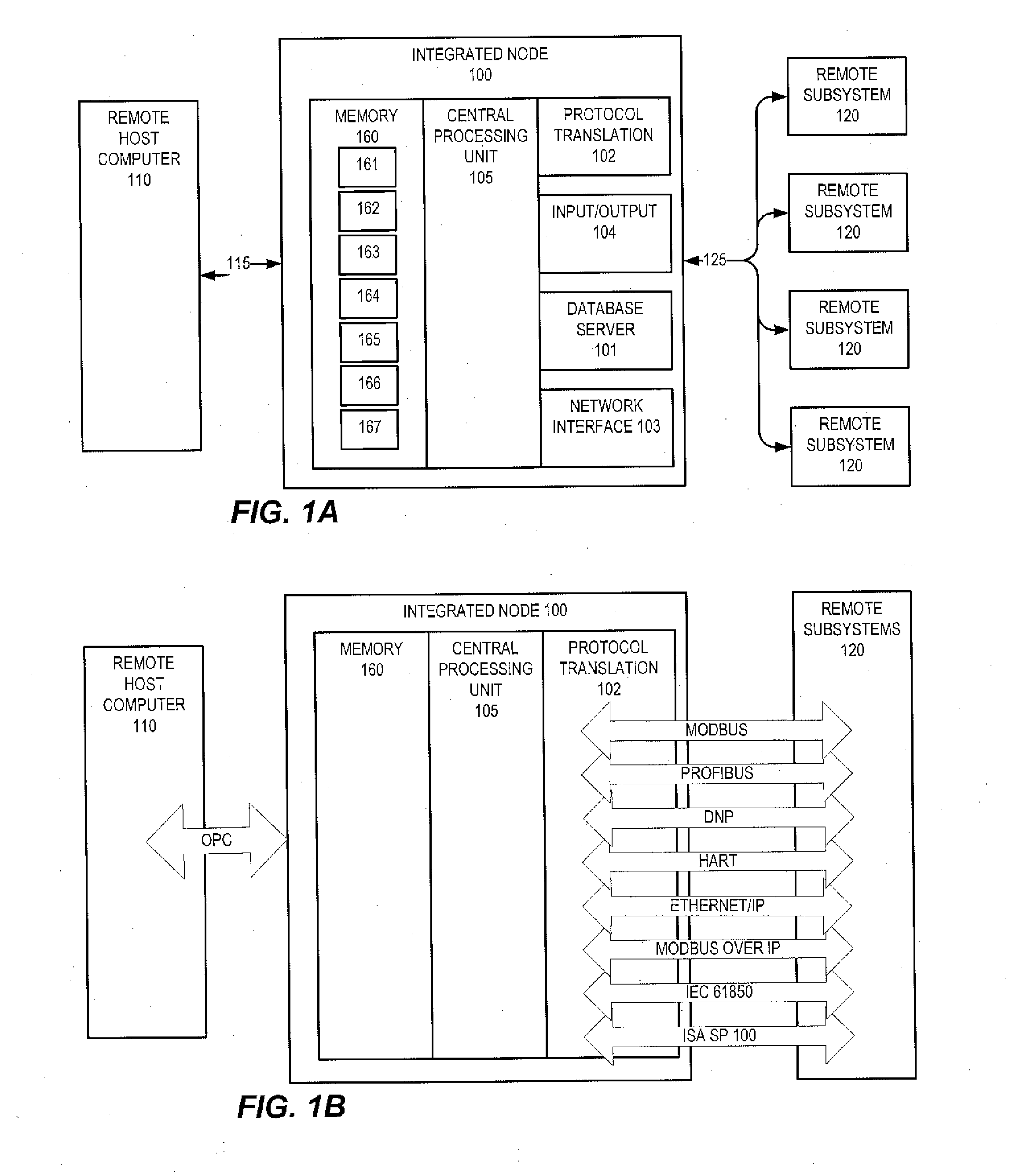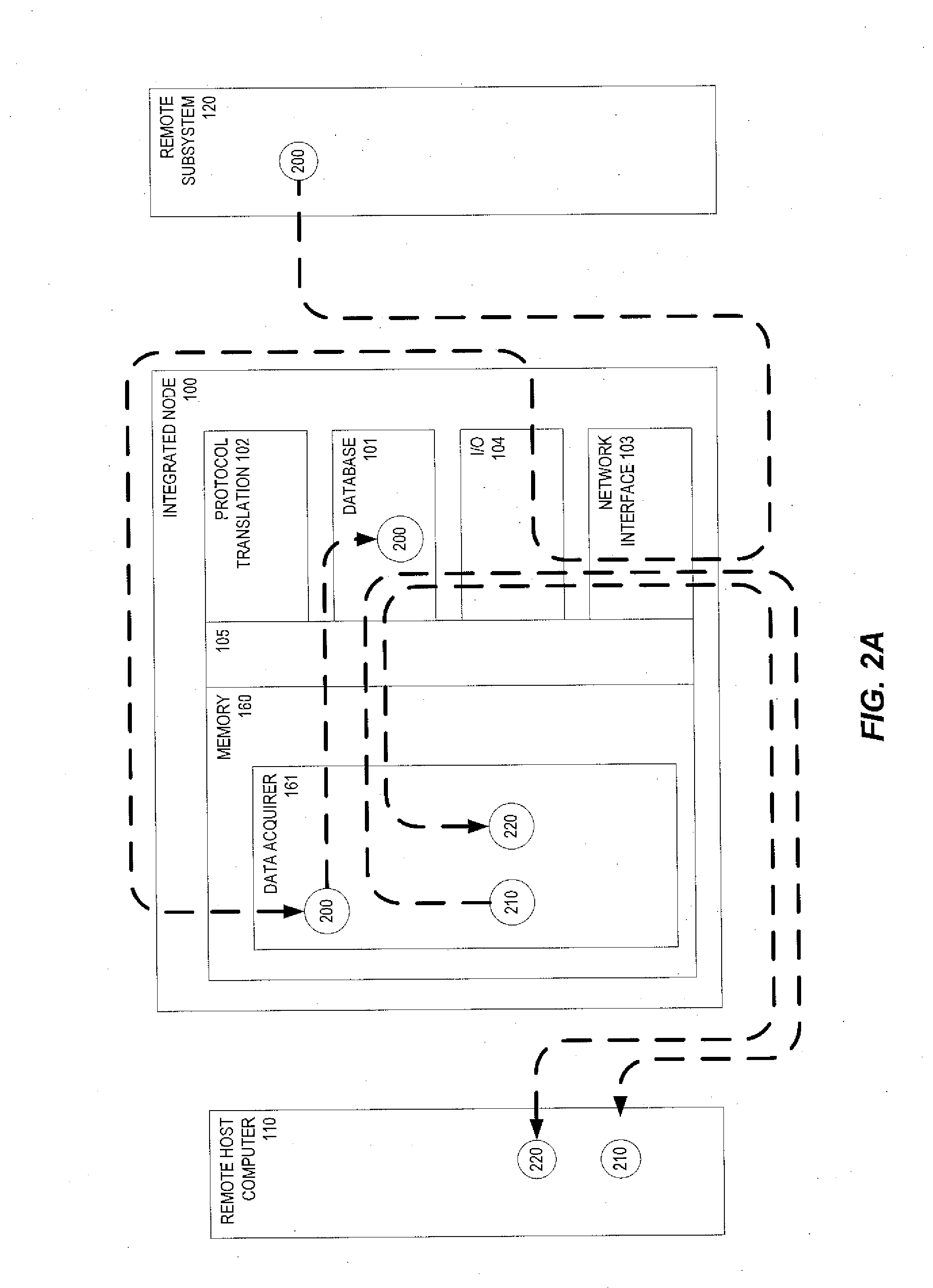[0007]Embodiments of the present invention provide an integrated node used to interface between a remote host
server and the plurality of remote subsystems in a process
automation environment to provide, in turn, for a
single point of control for data collection, monitoring, and restoration responsive to timestamps being synchronized to a single timing source, thereby enabling a more uniform basis for collection and restoration of data. Accordingly, embodiments of the present invention provide machines, computer-readable media having computer programs or
computer program product stored thereon, and computer-implemented methods to provide an integrated node for
data acquisition from process automation remote subsystems.
[0008]Exemplary embodiments of an integrated node, for example, integrates the functions of controller units, communications networking devices, and data storage servers into one unit. Embodiments of an integrated node can also, for example, employ an
Ethernet switch to support networking over multiple communication interfaces and transmit process data to a remote host sever over TCP / IP (
transmission control protocol and
the internet protocol, also referred to as
the internet protocol suite), thereby beneficially reducing the number of hardware components needed and allowing a simpler support model. Further, embodiments of an integrated node, for example, can employ an OPC server (also known as “
OLE for Process Control”), or any suitable server or drivers known to those having skill in the art, to support multiple communication protocols. Even further, embodiments of an integrated node can comprise a PLC or RTU, or employ the functionality of a PLC or RTU, for example through hardware or
software, to issue commands and collect and process data according to multiple process automation protocols without the need for multiple PLC or RTU components, thereby further reducing the number of hardware components needed and allowing a simpler support model. Furthermore, embodiments of an integrated node beneficially reduce the potential for data collection conflicts by providing
time synchronization among the subsystems and the remote server and beneficially providing
network monitoring and failure
recovery by restoring data transmissions in the event of a communications failure, including any type of network failure or systems failure, between the integrated node and the plurality of remote subsystems or between the integrated node and the remote server. Accordingly, embodiments of an integrated node simplify the support model, including deployment, maintenance, and operation, of a
process automation system by combining multiple systems into one
system that provides multi-
system functionality by incorporating the functionality of a PLC, RTU, and
Ethernet switch and supporting multiple interfaces, multiple protocols, and field-
system data retention through the addition of local data storage capacity.
[0009]Still further, the use of an integrated system, e.g., an embodiment of an integrated node, provides for a central point of control to enforce
time synchronization for the data and among the host, subsystems, and upper application
layers. For example, embodiments of an integrated node advantageously combine a TCP / IP
Ethernet Switch, PLC or RTU logic, input / output interfaces supporting multiple communication protocols and enabled with data storage capability, FTP
client / server support, and OPC interface capabilities. Embodiments of an integrated node, for example, advantageously store data having time-synchronization capability with the remote host server, thereby allowing the automation system to better tolerate failure or interruption of communications with the host or in the network, to minimize collection conflicts between captured data and host data used for
simulation and optimization, and minimize risk that a network failure or a host failure will result in loss of the collected data during the outage period, essentially regenerating data not transmitted during an outage or overload condition. Yet further, embodiments of an integrated node allow for reduced power requirements by minimizing the number of hardware components, and the associated power and floor
space requirements, in the field and by simplifying the support model in supporting any of multiple protocols and interface types.
[0021]Embodiments of the present invention can further provide an integrated node having a time-
synchronizer to synchronize an internal
clock in the remote host and in each of the remote subsystems, thereby resulting in the remote host and remote subsystems being time-synchronized with the remote host, according to a uniform time.
Time synchronization can be performed, as will be understood by those having skill in the art, continuously or on-demand based on preset synchronization criteria. The integrated node can also include a data acquirer positioned to periodically acquire time-stamped data from each of a plurality of remote time-synchronized subsystems. The data acquirer can further be positioned to archive the time-stamped data using the
database server.
[0024]Another exemplary embodiment of the present invention provides a computer-implemented method for allowing a uniform
recovery of interrupted data transmissions between a remote host and an integrated node, such as a PLC, that is positioned to acquire process data from a plurality of remote subsystems. The method includes detecting a time of a communications failure and a time of a corresponding communications recovery in a communications link between the integrated node and the remote host, provided that the integrated node and the remote host are time-synchronized according to a uniform time source. Embodiments of methods include reporting the time of the communications failure and the time of the communications recovery to the remote host so that the remote host can initiate a restoration of
missing data as a result of the communications failure.
[0027]Embodiments including a data reconciler can further include, for example, a
computer program or a computer program product stored in a memory that, when executed by the
central processing unit, causes the integrated node to determine an operating state of one or more process units of a plurality of remote time-synchronized subsystems, the determining operation being responsive to a plurality of verified measurements from one or more of the plurality of remote-time synchronized subsystems. The data reconciler including such computer program or computer program product, upon execution of the computer program or computer program product, can also cause the
programmable logic controller to determine a reconciliation model responsive to the plurality of verified measurements, the reconciliation model corresponding to one or more process units and the operating state for the one or more process units. The data reconciler can also cause the integrated node to reconcile the plurality of verified measurements responsive to the reconciliation model, the reconciliation operation being a sequential quadratic
programming algorithm, to thereby define a plurality of reconciled measurements. The data reconciler can also cause the
programmable logic controller to detect a change in the operating state of one or more process units responsive to a later plurality of verified measurements. The data reconciler can also cause the programmable logic controller to determine a new reconciliation model for the one or more process units responsive to the change in the operating state detected so that the reconciliation operation can proceed responsive to the new reconciliation model.
 Login to View More
Login to View More  Login to View More
Login to View More 


